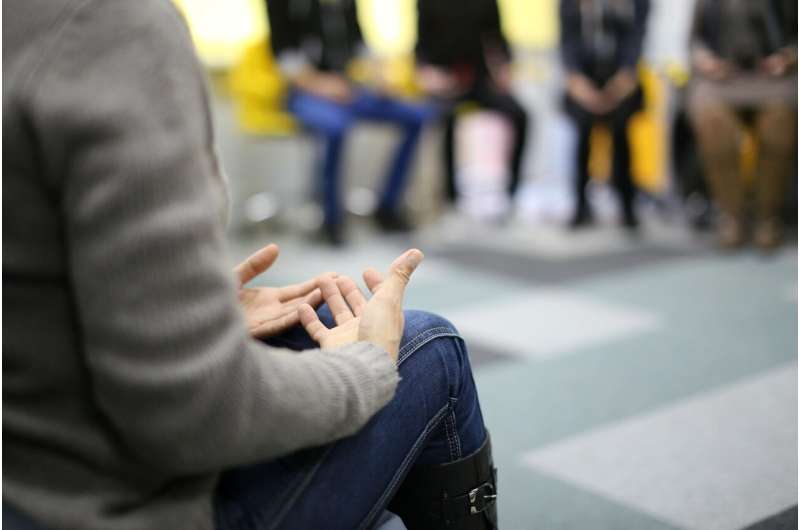This article has been reviewed according to Science X's editorial process and policies. Editors have highlighted the following attributes while ensuring the content's credibility:
fact-checked
peer-reviewed publication
trusted source
proofread
AA attendance lower among African American, Hispanic and young populations: Study

Alcoholics Anonymous has long been a cornerstone of treating alcohol use disorders in the United States. But even today, Americans are not accessing it equally, according to a new study in the Journal of Studies on Alcohol and Drugs.
Alcoholics Anonymous, or AA, got its start nearly 90 years ago and is famous for spurring the "12-step" approach to recovery—which includes acknowledging powerlessness over alcohol and giving your life over to a "higher power."
Over the years, AA and similar "mutual-help groups" have become a staple of treatment for alcohol and other drug use disorders, and research has proven they can help people achieve lasting recovery.
Yet few studies have looked at whether Americans are actually using such support groups equally. The new findings, published in the January issue of JSAD, show they are not—and those disparities are just as clear today as 20 years ago.
After adjusting for other factors, the researchers found that between 2000 and 2020, Black and Hispanic/Latinx Americans with an alcohol use disorder were about 40% less likely to have ever attended AA meetings versus their white counterparts.
An even greater divide was seen between people younger than 30 and relatively older adults: Among adults younger than 30, less than 5% had ever attended AA—versus about 12% of adults age 30 and up. After adjusting for other factors, the younger group attended AA at about a third of the rate of their older counterparts.
"This is concerning, because the disparities suggest that these groups—Black, Latinx and emerging adults—are not receiving optimal care," said lead researcher Sarah Zemore, Ph.D., a senior scientist with the Alcohol Research Group, in Emeryville, Calif.
"It's known that mutual-help groups can be quite effective in initiating and sustaining recovery," Zemore said.
In the United States, she noted, they've become a cornerstone of addressing substance use disorders. In fact, more Americans turn to the free and widely available support groups than to specialty substance use treatment (meaning inpatient or outpatient programs for alcohol and drug problems).
Why then do disparities in AA participation exist?
This study cannot answer that question, Zemore said. But she and her colleagues did find that the explanation does not appear to rest in disparities in use of specialty substance use treatment: When they looked only at study participants who had received specialty treatment for substance use, they saw the same disparities in AA attendance.
According to Zemore, that suggests there may be something about AA that is "not attractive" to young adults and people of color.
Some past studies have suggested as much, the researchers point out: People of color attending 12-step meetings have, for instance, reported conflicts with the program's general philosophy, as well as feelings of being scrutinized or discriminated against. Young adults, meanwhile, may often be turned off by the meetings' religious nature.
The current findings are based on data from the National Alcohol Survey, which collects information on Americans' drinking habits at roughly five-year intervals. The researchers focused on nearly 8,900 Americans who were surveyed between 2000 and 2020 and who reported ever having at least 2 of 11 symptoms used to diagnose an alcohol use disorder.
Gaps in AA attendance among people of color and young people were not explained by factors such as the severity of people's alcohol-related problems or whether they had received specialty treatment. When the researchers accounted for those factors, Black adults, Hispanic/Latinx adults and young adults were still less likely to have attended AA.
Over the years, AA has evolved, now offering meetings in different languages and specifically for people of color and women, for instance. Based on the new findings, though, disparities in attendance have not narrowed since 2000.
"This problem probably isn't going to be solved by AA alone," Zemore said.
The key ingredient in AA and similar programs, she noted, seems to be the change in people's social networks. That is, they offer a ready-made way to be around others who are working toward recovery.
AA is not the only option for people looking for peer support: Nationally, there are several mutual-help alternatives to 12-step programs, such as SMART Recovery and LifeRing.
It's not clear from this study, Zemore said, whether similar disparities exist in Americans' use of those alternative mutual-help groups.
More information: S. E. Zemore et al, Disparities in Alcoholics Anonymous participation from 2000 to 2020 among U.S. residents with an alcohol use disorder in the National Alcohol Survey. Journal of Studies on Alcohol and Drugs (2024). DOI: 10.15288/jsad.23-00086





















